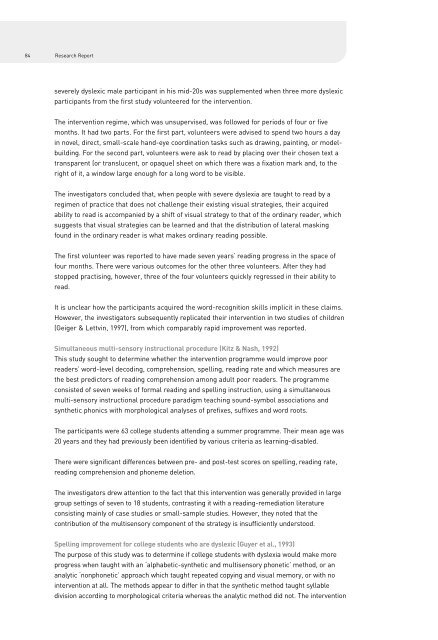01 NRDC Dyslexia 1-88 update - Texthelp
01 NRDC Dyslexia 1-88 update - Texthelp
01 NRDC Dyslexia 1-88 update - Texthelp
Create successful ePaper yourself
Turn your PDF publications into a flip-book with our unique Google optimized e-Paper software.
84<br />
Research Report<br />
severely dyslexic male participant in his mid-20s was supplemented when three more dyslexic<br />
participants from the first study volunteered for the intervention.<br />
The intervention regime, which was unsupervised, was followed for periods of four or five<br />
months. It had two parts. For the first part, volunteers were advised to spend two hours a day<br />
in novel, direct, small-scale hand-eye coordination tasks such as drawing, painting, or modelbuilding.<br />
For the second part, volunteers were ask to read by placing over their chosen text a<br />
transparent (or translucent, or opaque) sheet on which there was a fixation mark and, to the<br />
right of it, a window large enough for a long word to be visible.<br />
The investigators concluded that, when people with severe dyslexia are taught to read by a<br />
regimen of practice that does not challenge their existing visual strategies, their acquired<br />
ability to read is accompanied by a shift of visual strategy to that of the ordinary reader, which<br />
suggests that visual strategies can be learned and that the distribution of lateral masking<br />
found in the ordinary reader is what makes ordinary reading possible.<br />
The first volunteer was reported to have made seven years’ reading progress in the space of<br />
four months. There were various outcomes for the other three volunteers. After they had<br />
stopped practising, however, three of the four volunteers quickly regressed in their ability to<br />
read.<br />
It is unclear how the participants acquired the word-recognition skills implicit in these claims.<br />
However, the investigators subsequently replicated their intervention in two studies of children<br />
(Geiger & Lettvin, 1997), from which comparably rapid improvement was reported.<br />
Simultaneous multi-sensory instructional procedure (Kitz & Nash, 1992)<br />
This study sought to determine whether the intervention programme would improve poor<br />
readers’ word-level decoding, comprehension, spelling, reading rate and which measures are<br />
the best predictors of reading comprehension among adult poor readers. The programme<br />
consisted of seven weeks of formal reading and spelling instruction, using a simultaneous<br />
multi-sensory instructional procedure paradigm teaching sound-symbol associations and<br />
synthetic phonics with morphological analyses of prefixes, suffixes and word roots.<br />
The participants were 63 college students attending a summer programme. Their mean age was<br />
20 years and they had previously been identified by various criteria as learning-disabled.<br />
There were significant differences between pre- and post-test scores on spelling, reading rate,<br />
reading comprehension and phoneme deletion.<br />
The investigators drew attention to the fact that this intervention was generally provided in large<br />
group settings of seven to 18 students, contrasting it with a reading-remediation literature<br />
consisting mainly of case studies or small-sample studies. However, they noted that the<br />
contribution of the multisensory component of the strategy is insufficiently understood.<br />
Spelling improvement for college students who are dyslexic (Guyer et al., 1993)<br />
The purpose of this study was to determine if college students with dyslexia would make more<br />
progress when taught with an ‘alphabetic-synthetic and multisensory phonetic’ method, or an<br />
analytic ‘nonphonetic’ approach which taught repeated copying and visual memory, or with no<br />
intervention at all. The methods appear to differ in that the synthetic method taught syllable<br />
division according to morphological criteria whereas the analytic method did not. The intervention
















